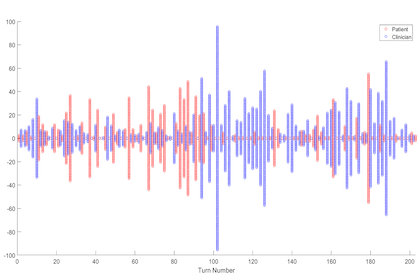Understanding what happens during important conversations between seriously ill people, their families and palliative care specialists – and how they vary by cultural, clinical, and situational contexts – is essential to guide healthcare communication improvement efforts. A new computer model developed by a team of UVM researchers offers an automated and valid tool for conducting large-scale scientific analyses of these conversations.

In this image, each vertical bar represents a speaker turn, and the height of each bar is proportional to the length of the turn, with patient turns in red and clinician turns in blue. (Courtesy of L. Clarfeld)
Conversations between seriously ill people, their families and palliative care specialists lead to better quality-of-life. Understanding what happens during these conversations – and particularly how they vary by cultural, clinical, and situational contexts – is essential to guide healthcare communication improvement efforts. To gain true understanding, new methods to study conversations in large, inclusive, and multi-site epidemiological studies are required. A new computer model offers an automated and valid tool for such large-scale scientific analyses.
Research results on this model were published July 1, 2021 in PLOS ONE.
Developed by a team of computer scientists, clinicians and engineers at the University of Vermont, the approach – called CODYM (COnversational DYnamics Model) analysis – uses simple behavioral state-based models (Markov Models) to capture the flow of information during different conversations, based on patterns in the lengths of alternating speaker turns.
To date, the conversation analysis process has typically relied on time-consuming manual transcription, detailed annotations, and required access to the highly private content of conversations.
“CODYMs are the first Markov Model to use speaker turn length as the fundamental unit of information and the first model of any type to provide concise, high-level, quantitative summaries of overall dependencies in sequences of speaker turn lengths,” says Laurence Clarfeld, Ph.D., lead author on the study and a UVM postdoctoral associate whose doctoral dissertation in computer science focused on this research topic.
Using a time-based definition of speaker turn length means that real-time automation and analysis of conversational dynamics can occur without transcription or stored audio, thus protecting the privacy of the conversation content, add the authors.
“We developed a computational model of information flow in serious illness that could become a fundamental tool in conversational epidemiology,” says coauthor Robert Gramling, M.D., D.Sc., professor of family medicine, Miller Chair in Palliative Medicine, and director of the Vermont Conversation Lab at the UVM’s Larner College of Medicine. “It predicts important and complex conversational processes, like emotion expression and future patterns of speaker turns.”
For the study, the researchers performed analyses to validate the CODYM model, “identify normative patterns of information flow in serious illness conversations and show how these patterns vary across narrative time and differ under expressions of anger, fear and sadness,” the authors write.
In addition to serving as a means for assessing and training healthcare providers, CODYMs could also be used to compare “conversational dynamics across language and culture, with the prospect of identifying universal similarities and unique ‘fingerprints’ of information flow,” the study authors state.
This publication represents the latest of several serious illness conversation dynamics studies conducted collaboratively over the past several years by Gramling, representing UVM’s Larner College of Medicine, and College of Engineering and Mathematical Sciences colleagues, including Clarfeld (now in the Rubenstein School of Environment and Natural Resources) and coauthors Margaret Eppstein, Ph.D., and Donna Rizzo, Ph.D.